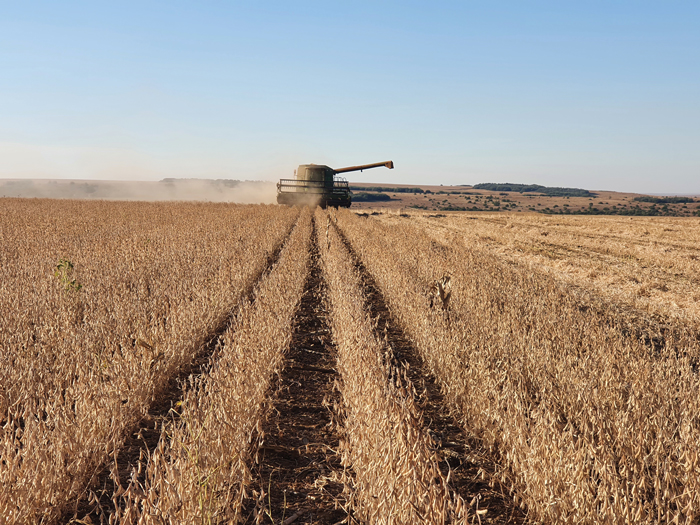May 2022
| PIETMAN BOTHA, INDEPENDENT AGRI- CULTURAL CONSULTANT |
 |
A Combine harvester is a complex machine that gathers, threshes and cleans grain. To do this the implement needs a power source which is the engine. Combines need to be properly equipped and adjusted for the crop to be harvested. To increase the effectiveness and efficiency, the machine’s downtime must be minimised and proper maintenance must be done in time.
Adjustments are important to minimise harvest losses and deliver a high-quality grain crop. The goal of proper adjustments is to achieve a smooth, even flow of crop material moving through the combine. Before you begin, get a comfortable chair, sit down and start reading the operator and workshop manuals of the combine. Begin with the manufacturer’s recommended settings and make adjustments according to the condition of the crop.
SAFETY AND MAINTENANCE
Safety and maintenance will save you time, money and tears. Always work safely around combine equipment and follow safety instructions in the operator’s manual. Many farm accidents happen around the harvesters.
Before harvest, follow the maintenance checklist provided by the manufacturer and inspect for any worn parts. If you already knew last season that the parts needed to be replaced but did not buy them you may want to kick yourself now because you will find that the parts often cost more than last season.
Start from the front of the harvester and first do the maintenance on the tractor or the engine. Change the oils and filters and make sure it is in good working condition.
The harvester stood in the barn for most of the off season and needs to be properly cleaned. Mice and rats make nests in the machines and it needs to be removed. Grease al the grease points and again oil the chains. Lubrication is important for the machine. Make sure the belts and chains are on tension and not cracked or damaged.
A header needs special attention. Examine the roller chains on a maize head or the knives on a cutter bar head for soybeans and small grains. In the threshing and separation area, check the rotor and concave for wear or damage. Look at the condition of the sieves in the cleaning shoe area and check for sharp edges on all augers which can lead to grain damage. Replace any worn parts as necessary for an efficient harvest.
MAIZE HEADER
The header is the first contact point with the crop and can be the largest source of grain loss. It cuts and gathers the crop.
On a maize header, gathering chains pull stalks back into the header, stripping rolls pull the stalks down, and deck plates pop ears off the stalks. Stripping roll spacing should be set according to stalk thickness. Deck plates need to be properly adjusted to minimise ear and kernel loss. Set deck plates as wide as possible without losing ears or shelling maize off the ear.
Gathering chains pull ears into a cross auger that delivers them to the centre of the head where they enter the feeder house. Auger clearances must be properly set to work efficiently.
When harvesting, it is important to match the feeder house and maize head gathering speed to the combine drive speed. If the gathering speed is too slow, maize stalks entering the header will be pushed forward and ear loss can occur. If the gathering speed is too fast, ears can be damaged with kernel loss as they impact deck plates. Speed settings are correctly matched when stalks are pulled straight down after entering the header and ears are gently snapped off without damage.
Look out for changes in crop and field conditions while harvesting and make adjustments accordingly.
There are aftermarket companies like Cerealis Precision that provide replacement spare parts that can help to increase the effectiveness of the machine.
FEEDER HOUSE
The feeder house is where the grain first enters the combine. Proper adjustments and settings need to be made according to the crop. It is important to set the proper height position of the feed drum to prevent grain damage.
Set the feed accelerator at a low speed so that whole ears are moved into the combine to start the threshing process. If the accelerator speed is set too fast, maize cobs can break apart and kernels can be lost before the threshing process begins.
THRESHING AND SEPARATING
Adjustments to threshing and separating parts of the combine are important for an efficient harvest. Threshing requires a balance between rotor speed and concave clearance. The cylinder or rotor speed is the leading cause of grain damage by the combine. Use the lowest possible rotor speed that will shell the grain. When setting the rotor speed and concave clearance, begin with factory recommended settings as a starting point and fine-tune for the crop and field conditions.
A properly adjusted rotor speed and concave clearance will detach most of the grain from the cob. If the rotor speed is too fast, maize ears will break apart and kernel damage can occur resulting in cracked grains and fines entering the grain tank. If the concave clearance is too wide, complete threshing will not occur and similar results as with excessive rotor speed will occur with lots of split cobs showing up in the tank.
For good threshing and separation, follow these guidelines:
GRAIN CLEANING
After threshing, the grain is separated from the non-grain crop material by the chaffer and shoe sieves as well as the cleaning fan. The chaffer is the upper sieve that allows all grain and unthreshed cobs or pods through to the shoe sieves which allows only grain to pass. Unthreshed crop portions go into tailings and return to the rotor cage for rethreshing.
Sieve and fan settings are critical to deliver a clean, high-quality end product and should be set to specifications. If the fan speed is too low, you will see pieces of stalks and cobs in the grain tank. If the fan speed is too high, you can lose grain out the back of the combine. Sieve adjustments should work in tandem with fan speed for best results.
For more help contact your harvester manufacturer and an experienced mechanic that can repair the harvester. It is a specialised machine, so it makes sense to get someone with knowledge to repair and setup the machine.

Publication: May 2022
Section: Pula/Imvula